
Acanthaceae is a family of dicotyledonous flowering plants containing almost 250 genera and about 2500 species. Most are tropical herbs, shrubs, or twining vines; some are epiphytes. Only a few species are distributed in temperate regions. The four main centres of distribution are Indonesia and Malaysia, Africa, Brazil, and Central America. Representatives of the family can be found in nearly every habitat, including dense or open forests, scrublands, wet fields and valleys, sea coast and marine areas, swamps, and mangrove forests.
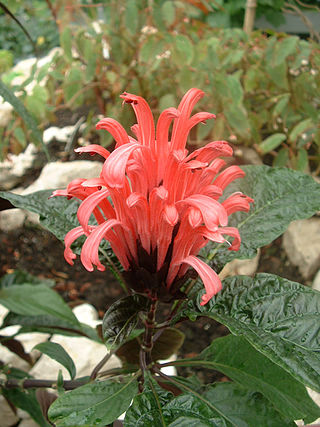
Justicia is a genus of flowering plants in the family Acanthaceae. It is the largest genus within the family, encompassing around 700 species with hundreds more as yet unresolved. They are native to tropical to warm temperate regions of the Americas, India, and Africa. The genus serves as host to many butterfly species, such as Anartia fatima. Common names include water-willow and shrimp plant, the latter from the inflorescences, which resemble a shrimp in some species. The generic name honours Scottish horticulturist James Justice (1698–1763). They are closely related to Pachystachys.

The genus Asystasia belongs to the family Acanthaceae and comprises 59 species found in the tropics of Africa, Asia, Australia, and New Guinea. It includes the weedy species Asystasia gangetica.
Acanthopale is a plant genus of shrubs or subshrubs in the Acanthaceae plant family. The genus name is based on the classic Greek words for thorn ákantha and stake palum. Some species in the genus are cultivated as ornamental plants.

Anisotes is a genus of Afrotropical plants in the family Acanthaceae. The genus is morphologically similar to Metarungia, from which it differs mainly in the dehiscence of the fruit capsule, and the nature of the placenta. Placentas remain attached to the inner surface of fruit capsules in Anisotes.

Blepharis is a genus of plant in family Acanthaceae. It contains around 128 species found in seasonally dry to arid habitats from Africa through Arabia to Southeast Asia. In section Acanthodium, there are 13–15 species that use the C4 carbon fixation pathway. Phylogenetic analysis suggests that this pathway evolved up to three times independently in the genus over the last five million years.

Brachystephanus is a genus of flowering plants in the family Acanthaceae. It includes 21 species native to tropical Africa and Madagascar.

Brillantaisia is a genus of plants in the family Acanthaceae. They are native to the African tropics and subtropics, including Madagascar. They may grow from 20 cm to 2 m in height. Their hirsute stems are square in cross-section and their heart-shaped leaves have an opposite arrangement. Their purple or white pea-like flowers produce long, cigar-shaped seed pods. They reproduce easily from seeds or vegetatively. One species, B. lamium, is invasive in Queensland.

Isoglossa is a genus of flowering plants in the family Acanthaceae.

Neuracanthus is a genus of plants in the family Acanthaceae.

Pseuderanthemum is a genus of plants in family Acanthaceae with a pantropical distribution.
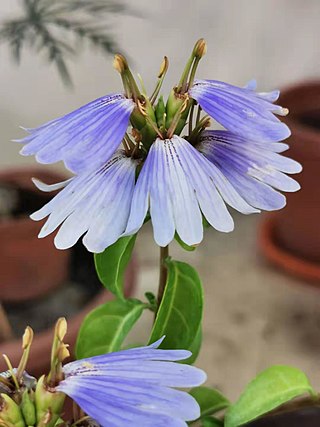
Sclerochiton is a genus of plants in the family Acanthaceae.
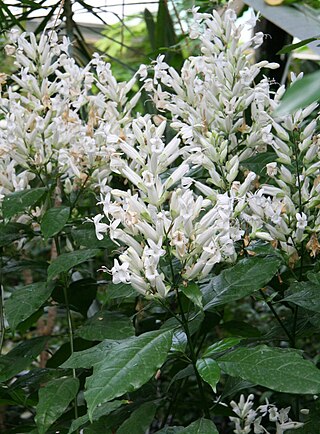
Whitfieldia is a genus of plants in the family Acanthaceae with about 14 species in tropical Africa.
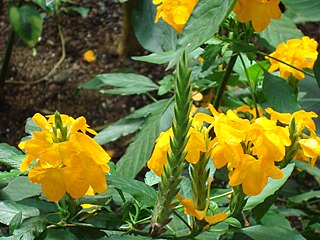
Crossandra is a genus of plants in the family Acanthaceae, comprising 54 species that occur in Africa, Madagascar, Arabia and the Indian subcontinent. Some species, especially Crossandra infundibuliformis, are cultivated for their brightly colored flowers.
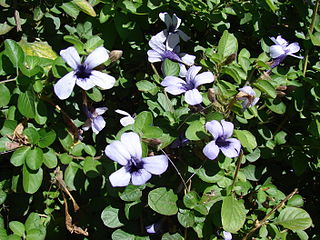
Dyschoriste is a genus of flowering plants in the family Acanthaceae. It includes 98 species native to the tropics and subtropics of the Americas, sub-Saharan Africa, and southern Asia. Members of the genus are commonly known as snakeherb.

Ecbolium is a genus of flowering plants in the family Acanthaceae. It includes 26 species native to southern and eastern Africa, the Arabian Peninsula, Indian subcontinent, and Myanmar.
Mellera is a genus of flowering plants belonging to the family Acanthaceae.
Pogonospermum is a genus of flowering plants in the family Acanthaceae. It includes 34 species native to sub-Saharan Africa.














